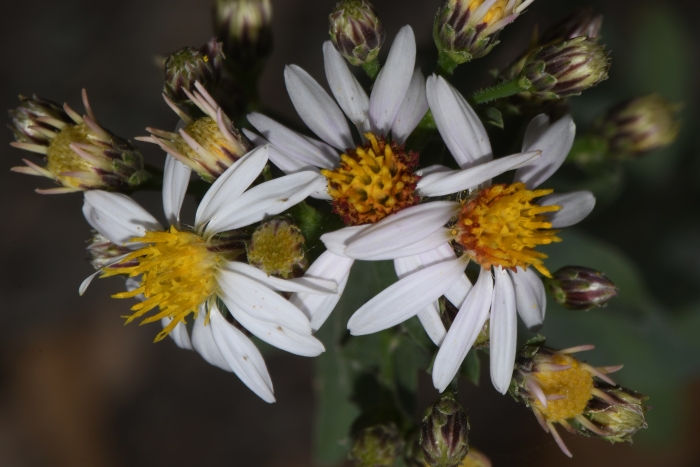Gray Aster
(Eurybia glauca)
Gray Aster (Eurybia glauca)
/
/

© Brian Finzel
CC BY-SA 4.0
Image By:
© Brian Finzel
Recorded By:
Copyright:
CC BY-SA 4.0
Copyright Notice:
Photo by: © Brian Finzel | License Type: CC BY-SA 4.0 | License URL: http://creativecommons.org/licenses/by-sa/4.0/ | Uploader: finzelflowers | Publisher: iNaturalist |

























Estimated Native Range
Summary
Eurybia glauca, commonly known as Gray Aster, is a perennial herb or subshrub native to mountain meadows, open coniferous forests, and the edges of woodlands in the western United States. Its range includes Arizona, New Mexico, Utah, Colorado, and Wyoming, with some populations in Idaho and Montana. Gray Aster typically grows up to 28 inches tall from a woody rhizome and can spread to form clumps. The plant is characterized by its flat-topped clusters of flower heads, each displaying 8-19 lavender ray florets surrounding 12-32 yellow or purplish disc florets, blooming from late summer to early fall. The flowers are moderately showy and attract pollinators such as bees and butterflies.
Gray Aster is valued for its drought tolerance and ability to thrive in poor soils, making it a suitable choice for rock gardens, native plant gardens, and restoration projects. It is also used in border plantings for its late-season blooms. In cultivation, Eurybia glauca requires well-drained soil, tolerates a range of soil types, and prefers full sun to partial shade. While generally low-maintenance, it can be susceptible to powdery mildew in humid conditions. There are no widely known popular cultivars of this species, but its natural form is well-regarded for its hardiness and ecological contributions.CC BY-SA 4.0
Gray Aster is valued for its drought tolerance and ability to thrive in poor soils, making it a suitable choice for rock gardens, native plant gardens, and restoration projects. It is also used in border plantings for its late-season blooms. In cultivation, Eurybia glauca requires well-drained soil, tolerates a range of soil types, and prefers full sun to partial shade. While generally low-maintenance, it can be susceptible to powdery mildew in humid conditions. There are no widely known popular cultivars of this species, but its natural form is well-regarded for its hardiness and ecological contributions.CC BY-SA 4.0
Plant Description
- Plant Type: Herb
- Height: 1.5-2.5 feet
- Width: 1.5-2.5 feet
- Growth Rate: Moderate
- Flower Color: Purple
- Flowering Season: Summer, Fall
- Leaf Retention: Deciduous
Growth Requirements
- Sun: Full Sun, Part Shade
- Water: Medium
- Drainage: Fast, Medium
Common Uses
Border Plant, Butterfly Garden, Low Maintenance
Natural Habitat
Native to mountain meadows, open coniferous forests, and the edges of woodlands in the western United States
Other Names
Common Names: Glaucous Aster, White Woodland Aster, Gray Aster, White Aster, Bigleaf Aster
Scientific Names: , Eurybia glauca, Aster glaucodes, Aster glaucodes subsp. glaucodes, Aster glaucodes var. formosus, Aster glaucodes var. glaucodes, Aster glaucoides, Aster glaucoides subsp. pulcher, Aster glaucoides var. formosus, Aster glaucoides var. pulcher
GBIF Accepted Name: